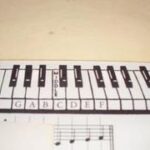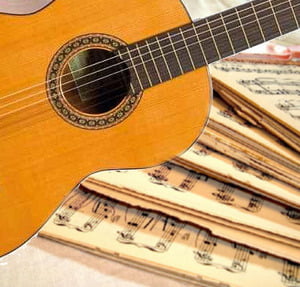Barre chords are often discussed, more often cursed, and frequently avoided.
This paper will attempt to analyze the factors necessary for successful barres
and offer a technique which can make barre chords both easier and more
powerful.
Contents:
1. Guitar Setup
2. Holding the Guitar
3. The Secret Technique
4. Advantages of the Secret Technique
5. Right hand notes
1. Guitar Setup
– – – – – – – – – –
In order to have any success playing barre chords, your guitar must be
properly set up. The factors to consider in the setup are:
== neck angle
== action
== string gauge
Neck angle is the relationship between the fretboard and the top of the
guitar. Basically, they must be nearly flat in relation to each other; no
curves or twists.
Action is the height of the strings above the frets. It is usually measured
at the 12th fret or where the neck meets the body of the guitar.
Together, neck angle and action have important effect on the quality and
difficulty of barring chords. If the action is too low, barre chords will
“buzz” and if action is too high, barre chords will be difficult to play at
all. The neck angle must be set before the action and can usually be adjusted
by the truss rod ( if present). More serious problems occasionally require
that the neck be reset. Action is then set by adjustments to the nut and
saddle.
Style of playing must be considered when setting the action. Generally,
action will have to be higher for aggressive players; a hard driving flat
picker will require higher action than a fingerpicker with a light touch.
This is also where string gauge comes into play: the more aggressive player
will usually want heavier gauge strings.
Heavier gauge strings effect action in two ways: diameter and tension.
Heavier gauges are physically larger and therefore will tend to lower the
action by being closer to the frets. However, their higher tension will pull
harder on the neck and tend to raise the action. These offsetting tendencies
may cancel each other out making changes in string gauge have no net effect on
the action.
The lighter the string gauge, the easier they are to barre. The tradeoff is
that lighter gauge strings produce less volume.
Therefore, to make barre chords as easy as possible, choose the lightest gauge
string which suits the style, attack, and volume requirements of your playing.
Then set the neck angle and adjust the action as low as possible; just make
sure that there is no buzz with your most aggressive attack and a full barre
anywhere along the neck.
While making these adjustments to your guitar are not particularly difficult,
it would probably be worthwhile to scrape together the cash to pay a good
luthier to do it for you. Be sure he knows the gauge of the strings you will
be using and how aggressive your playing style is. The fee should be nominal
and the job will be done right. However, when it is done the cost will be
worth the enjoyment and ease of playing a well adjusted guitar.
One final note: changes in the humidity of your guitar usually first became
apparent in the action. This is more noticeable in solid wood guitars than in
plywood guitars. If the strings seem to suddenly start buzzing or if the
action seems higher, change in humidity is the most probable cause.
The bottom line is, keep your guitar’s humidity constant: keep the guitar in it’s
case when not in use; keep it away from direct sources of heat; and use a case
humidifier during the winter when the house is being heated. For a more
thorough discussion there is an excellent white paper on humidity and guitars
available in the Tech Sheet section of the Taylor Guitar web site at
www.taylorguitars.com.
2. Holding the Guitar
– – – – – – – – – – – – – –
In order to play barres, it is important that your hands are in no way
involved in holding your guitar; they must be free to play it.
Get into your playing position and completely relax both hands. Let your left
hand (if you play right handed) hang down along your side. If the guitar
feels secure and comfortable, you are OK. If you are uncomfortable relaxing
your hands, or the guitar starts slipping, you need to refine how you hold
your guitar.
If you use a strap, tighten the strap so that the guitar is held in it’s
playing position without using your hands.
If you do not use a strap, sit so that the leg on which the guitar rests is
level or slightly raised. If you play right handed and the guitar is on your
left leg, you will be going toward the ‘classical’ position. If the guitar is
on your right leg, you will be going toward a neck flat position like that
used by Delta blues players. In either case, the guitar is secured in
position against your chest by your right forearm.
Overall, you should be completely relaxed; there should be no tension anywhere
in your body. Without getting into a sermon on holding the guitar, let me
just note that the technique which follows is somewhat easier if the neck is
up from the horizontal and the closer it gets to 45 degrees, the easier it is
to employ. However, I use the technique in all positions; I move the neck up
and down because I find that different styles of music are easier to play with
different neck positions. But that is a different discussion.
3. The Secret Technique for Perfect Barres
– – – – – – – – – – – – – – – – – – – – – – – – – – – – –
Most beginning guitar players start out trying to play a full barre F chord in
the first position. Quite simply, this is THE most difficult chord to barre
because it is right next to the nut. That said, here is the secret:
Great barre chords are played with the BACK, not the hands.
This is much more difficult to explain than to demonstrate, so please stay
with me.
Step 1.
Put down your guitar or anything else in your hands. Keeping your back erect
and straight, raise your arms so that your elbows are level with your
shoulders and your hands are in front of your chin. Now move your arms back
as if you are trying to fold in half and make your elbows meet behind your
neck. Note the feeling in your shoulders. This feeling should be that of
trying to make your shoulder blades touch.
Step 2.
Put your arms down to your sides. Repeat the motion with just your shoulders:
pull your shoulders back and try to make your shoulder blades touch. Relax
then pull back again. Do this several times and become familiar with the
feeling.
Step 3.
The next thing to consider is the left index finger. (This assumes a right
handed player. Left handed players reverse left and right hands in this and
following steps.) This finger must be taught to lie perfectly flat on the
fingerboard. To get a sense of this position, make a fist with your right
hand a place it against the palm of your left hand so that your forearms are
perpendicular. You should look like a kung-fu fighter about to go into
battle.
Now fold the fingers of your left hand down so that the left index
finger is laying full length along the back of your right hand while your
right fist stays flat against your left palm. It may be necessary slide your
fist slightly down toward the heel of your palm in order to get the finger
flat. Carefully holding the left hand in its position, remove your fist and
look at your left hand. This position, with the index finger perfectly
straight and perpendicular to the palm, is how the barre should be held
against the guitar.
Step 4.
Pick up your guitar and get into playing position. Get your left finger flat
as you just learned and place it at the 5th fret. Now, you are going to pull
all six strings down with that finger using the motion learned in step 2 .
Using the left hand by itself will make the guitar neck come back and the
guitar start to leave your lap; to counter that, balance the pull of your
left hand by pulling with the inside of your right forearm where it comes over
the guitar.
The complete motion, then, is pull the shoulders back, pulling on
the guitar with your left forefinger (the Barre) and your right inside
forearm, as if you are trying to break the guitar across your chest. Leave
the other fingers of the left hand off the fingerboard for now. Keep the left
thumb relaxed; at the most it should rest lightly on the back of the neck.
Strum across all six strings and see if each string plays clean and clear.
Relax your back and arms.
Repeat this step several times. Carefully check that the barre finger is
straight. Pull back evenly with both arms using the muscles in the middle of
your back. The guitar should not move when you pull the barre. There should
be no tension anywhere in your body except the middle of your back, your left
index finger, and the inside of your right forearm. Do not use your left
thumb to squeeze the barre. Using your arms and back to pull the barre finger
against the fingerboard, you should be able to make all six strings sound
clear without your left thumb even touching the back of the neck.
>>> THE MOST IMPORTANT SINGLE THING TO REMEMBER IS
RELAX YOUR BACK WHEN YOU ARE THROUGH. <<<
If you forget to relax, your back will cramp. Relaxing will become automatic
with practice but you must consciously do it at first.
Step 5.
Add fingers to the chord. Make an E chord. Usually this will be played with
the first three fingers: index finger at the first fret of the third (G)
string, middle finger at the second fret of the fifth (A) string, and the ring
finger at the second fret of the fourth (D) string. Now change your fingers
so that you are using the second finger on the G string, the third finger on
the A string, and the fourth finger on the D string. You are now holding the
moveable E chord form. Slide your fingers up to the sixth and seventh frets
and use your index finger to barre the fifth fret. Pull the chord in with
your back and arms and strum. You should hear a nice clear six note A chord.
Relax and slide the barre down to the third fret. Pull the chord in with your
back and arms and strum. You should hear a nice clear G chord. Remember not
to use the thumb; at most, rest it lightly on the back of the neck.
Continue practicing this chord form, sliding it up a down between the third
and eighth frets; the barre chords are easiest in this range. Once you can
play all of these cleanly, start working down to the third, second, and first
frets; soon you will be able to play the dreaded full-barre F chord. Also
work as far up the neck as you can; how far you go will depend on your guitar
type, cutaway etc. In the higher positions the issue is not so much string
tension as closer fret spacing.
This may seem like a tremendous amount of muscle involvement to get a barre.
However, one of the fundamental principles of guitar playing is economy of
movement and effort: do not lift your fingers any higher than necessary to
clear the strings and do not press any harder than necessary to produce a
clear note. The same applies to this technique. Once the motion is
understood, it should be very subtle; a slight tightening of the back and
arms. After some practice it becomes automatic and unnoticeable.
Remember to keep the left thumb relaxed, the left index finger straight, pull
with the back, and relax your back when releasing the chord.
Practice the technique using other movable chord forms.
4. Advantages of the Secret Technique
– – – – – – – – – – – – – – – – – – – – – – – – – –
The power of this technique lies in the physiology of the forearm. If you
squeeze a barre with your left thumb and index finger, all of the muscles of
the forearm are tightened and the freedom of motion of the remaining three
fingers is severely limited. Try it. Squeeze a barre with the thumb and
index finger; then wiggle the second, third, and fourth fingers of your left
hand. Notice how sluggish they feel. Relax the thumb and pull a barre with
your back and arms; wiggle your fingers again. Notice how much freer they
feel.
With the ease of motion thus gained, chord changes in a barre are much easier.
It will also be very easy to play scales under a barre.
All of the notes of the C major scale in the first position are:
E string: open, 1st fret, 3rd fret
A string: open, 2nd fret, 3rd fret
D string: open, 2nd fret, 3rd fret
G string: open, 2nd fret
B string: open, 1st fret, 3rd fret
E string: open, 1st fret, 3rd fret
Practice this scale up and down using the second, third, and fourth fingers of
the left hand. Now pull a barre at the fifth fret using the Secret Technique.
Play the pattern above where the ‘open’ notes are played at the barre and the
1st, 2nd, and 3rd frets become the 6th, 7th, and 8th frets. Remember to keep
the left thumb relaxed.
The full potential of this technique should start to become evident. Play
with it. Explore the possibilities. As with anything new, give it time.
Practice slowly and make each note ring clear and clean. And most important,
remember to relax your back when you release the chord.
5. Right hand notes
– – – – – – – – – – – – –
I am a fingerstyle player and I know this technique works because I have used
it for over twenty years. However, I have never learned to use a pick. I can
foresee some complaint that the Secret Technique won’t work for pickers whose
picking motion is a strum that originates from the elbow since they would be
required to pull in with the forearm while moving it up and down. This may be
true. However, I would suggest that they investigate moving their picking
motion from the elbow to the wrist; the Secret Technique would then work
because picking would be done by rotating the wrist while holding the guitar
with the forearm during a barre.
Since I have no personal experience in this
area, I can only point to Les Paul. Les’ right elbow was irreparably damaged
in a motor vehicle accident. He directed that the elbow be set at an angle
that allowed him to play the guitar. He has lived and played for many years
with his elbow fixed in one position and all the picking motion coming from
the rotation of his wrist.




